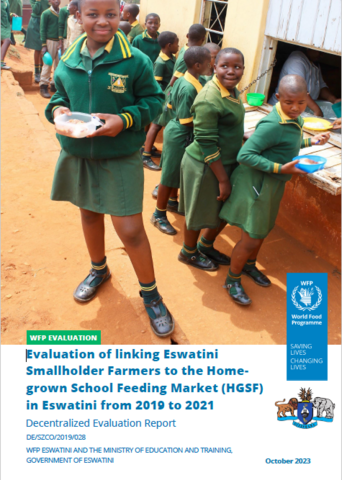
The evaluation was commissioned to provide lessons on the implementation of WFP supported interventions aligned to its current Country Strategic Plan (CSP), particularly Strategic outcome 2 (SO2) and Strategic outcome 3 (SO3). It was also commissioned to inform the design of the new CSP and provide the Government of Eswatini with evidence on potential expansion of the HGSF model across the country. With dual objectives of accountability and learning, the evaluation placed greater emphasis on learning. In relation to accountability, the evaluation assessed and reported on the performance and the results of linking Eswatini smallholder farmers (SHF) to the school feeding market and, the learning aspect determined the successes and shortcomings of the HGSF pilot, what worked, what did not work, adjustments required and the integration of gender and human rights. The evaluation provides evidence base for future operational and strategic decisions. The evaluation assessed the relevance/appropriateness, effectiveness, efficiency, coherence, sustainability, and scalability of the HGSF pilot. It covered agriculture production, market linkage and capacity strengthening activities.
Key evaluation findings include:
- The HGSF contributed to a moderate increase in school enrolment but due to the COVID-19 impact, the effect on attendance was not noticeable. Despite the commendable enhancements in the school meal diversity and portion size, most children were dissatisfied.
- An increase was observed in the number of schools utilizing gardens to support school meals under the HGSF pilot although most schools have not yet embraced this practice, in line with the HGSF principles.
- There was an increase in the number of schools utilizing gardens to support school meals under the HGSF pilot, which is positive. Nonetheless, most schools have not yet embraced this practice.
- The grain procurement model benefited farmers by reducing transaction costs; nevertheless, its efficiency was impeded by the double-handling process carried out by WFP. The menu under HGSF also incurred a slightly higher cost compared to the conventional National School Feeding Programme (NSFP).
- The HGSF program has demonstrated added value across various dimensions, including improved nutrition, enhanced food security, promotion of economic empowerment, stimulation of the local economy, support for education, provision of social protection, fostering collaboration, and contribution to sustainable development.
Key recommendations from the evaluation included:
- Develop a robust policy framework that mandates the inclusion of HGSF in the NSFP in Eswatini.
- Adjust the design of HGSF to set realistic targets for scaling with the purpose of establishing a pathway for the progressive adoption of a model for HGSF schools that will include all necessary components – including complimentary services.
- Strengthen mainstreaming of gender, disadvantaged groups (people living with disabilities) and human rights in the design and implementation of HGSF.
- Strengthen capacities of all stakeholders at the school and farmer levels through training and capacity-building focusing on gaps identified in the evaluation and particularly gender equality, disability inclusion, and the empowerment of all project participants.
- Implement a robust monitoring and evaluation framework that includes gender and disability-disaggregated data collection.
- Enhance the cost efficiency of the HGSF model by sustaining support for facilitation of profitable market access, particularly for women smallholder farmers and farmers with very small holdings, strengthening supply chain and logistics, developing a more nuanced/balanced approach to cost analysis that reflects the specific objectives, outcomes, and benefits of the HGSF model.



